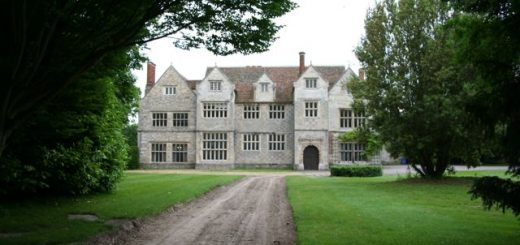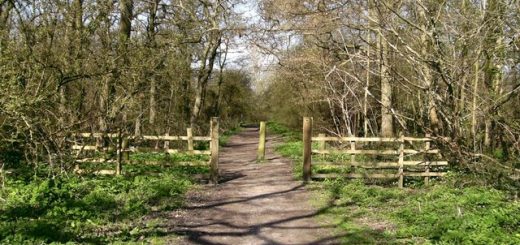Hackwood House
According to The Haunted Homes and Family Traditions of Great Britain by John Ingram (1897), the Saunders Newsletter which was a daily paper that running between 1755 and 1879 (being published daily from 1777) carried the following story concerning an experience at Hackwood House in one of it’s April 1862 publications.
Really, what with Mr. Home, Mr. Forster, and Sir Bulwer Lytton’s Strange Story, London Society seems just now affected with a general phantom mania. The last new phase of the malady is a ghost story which has lately obtained extensive currency in what are called the upper circles and which claims for its believers two counsel learned in the law, and the Lord High Chancellor himself. I don’t pretend to vouch that the story can pretend to the ‘ghost’ of a foundation for its existence, I merely testify that it is being talked of by ‘everybody’, and that the first question asked at most dinner-tables is, ‘Have you heard of Lord Westbury’s ghost?’
 Given the above introduction we can assume that the author was not convinced about this ghost or any hauntings by the sound of it and was probably biased, however it does make you wonder how much the story was altered through its constant retelling among the gentry.
Given the above introduction we can assume that the author was not convinced about this ghost or any hauntings by the sound of it and was probably biased, however it does make you wonder how much the story was altered through its constant retelling among the gentry.
Lord Westbury lately purchased Hackwood House, an old mansion near Basingstoke, the property of Lord Bolton. Snatching a spare day or two to obtain a more minute inspection of his investment, he took with him two of the gentlemen belonging to his official establishment, both members of the learned profession. On separating for the night, the bedroom destined for one of them, a Mr. R (premised by Ingram to be Henry Phillip Roche a Registrar of the London Court of Bankruptcy) , was found to be on the opposite side of the hall to those of the other gentlemen ; he therefore shook hands and said ‘ good-night’ in the hall, leaving the others talking there. He had not been very long asleep before he felt’ himself awoke, but could neither hear nor perceive anything. By degrees, however, he became conscious of something luminous on the side of the room opposite his bed, which gradually assumed the appearance of a woman clothed in grey. He at first thought it was an optical illusion, next that his companions were playing him some phosphoric trick, and then, turning round, he composed himself to sleep again.
Further on in the night he was awoke again, and then at once he saw the same figure brilliantly conspicuous on the wall. Whilst he was gazing at it, it seemed to leave the wall and advance into the middle of the apartment. He immediately jumped out of bed, rushed to it, and, of course, found nothing. He was so impressed with the power of the delusion, that he found it impossible to seek any more sleep, and, as the day was beginning to break, he dressed and made his way into the grounds, where he walked for some time, pondering over the illusion so forcibly produced upon him.
On his return to his room he wrote out an exact account of what he thought he had seen, it being then quite clear to him that it was no trick played by others, but simply an hallucination of his own brain. At the breakfast-table, however, he began to fancy that he had been cleverly imposed on by his friends, as they commenced at once bantering him on his night’s rest, broken sleep, and so forth Wishing to detect them if possible, he pretended unconsciousness and utter ignorance of their meaning, when, to his horror, one of them exclaimed, ‘ Come, come, don’t think we didn’t see one of the women in grey follow you into your room last night.’ He rushed up-stairs, produced his written account, which he gave them to read, and the consternation became general. On inquiry, of course, they found the legend of a murder done in the days of yore, and this Lord Chancellor is supposed to be exceedingly vexed at an incident which has decidedly shut up one room in his house for ever, if not, in all probability, tabooed the mansion altogether. Thus much do the ‘ upper ten thousand ‘ aver how truly is quite another question.”
Hackwood House dates back to 1683 and was built by the Marquis of Winchester following the restoration of the Monarchy to replace Basing House which was destroyed by Oliver Cromwell in October 1645 during the English Civil War. Member of Parliament, Charles Paulet (born 1625 – died 27 February 1699), 6th Marquis of Winchester was created 1st Duke of Bolton on 10th April 1689, the eve of William and Mary’s Coronation. Admiral Harry Powlett, 6th Duke of Bolton (born 6 November 1720 – died 25 December 1794) had no male heir and the dukedom of Bolton died with him in Hackwood House on Christmas Day 1794. The House, along with other properties in Duke Bolton’s estate including Bolton Castle and Bolton Halll in Yorkshire passed to Thomas Orde-Powlett (born 30 August 1740 – died at Hackwood 30 July 1807). Thomas (created 1st Baron Bolton of Bolton Castle on 20 October 1797) was the husband of Jean Mary Browne-Powlett, the daughter of Sir Charles Powlett, 5th Duke of Bolton and niece of Harry Powlett, 6th and last Duke of Bolton.
In 1850 the Bolton family moved to Bolton Hall and Hackwood House was leased out. The above article implied that Richard Bethell, 1st Baron Westbury (born 30 June 1800 – died 20 July 1873) had purchased Hackwood, but, I believe this was not the case. The timing of the experience though would have likely placed it during his term as Lord Chancellor of Great Britain (1861 – 1865).
Others who leased the property include the Earl of Wilton, the Belgian Royal Family (during World War I) and George Nathaniel Curzon, 1st Marquess Curzon of Kedleston (born 11 January 1859 – died 20 March 1925) Vicroy of India and Leader of The House of Lords.
In 1935 the Hackwood estate, along with the Basing and Winslade estate were sold by the Bolton’s to newspaper magnate William Ewart Berry, 1st Viscount Camrose (born 23 June 1879 – died 15 June 1954) who spent a few years refurbishing Hackwood House before allowing the Royal Canadian Army to use it as a hospital between 1940 and 1945 (Word War II).
The estate passed to John Seymour Berry, 2nd Viscount Camrose (born 12 July 1909 – died 15 February 1995) and following the death of his wife Joan Aly Khan (Princess Tajudowlah) in 1997 Hackwood was again put on the market.
Ghost?
Apart from the popularly reported mid 19th century experience mentioned above I am unaware of any other incidents, either before or since that support this reputed haunting.




Recent Comments